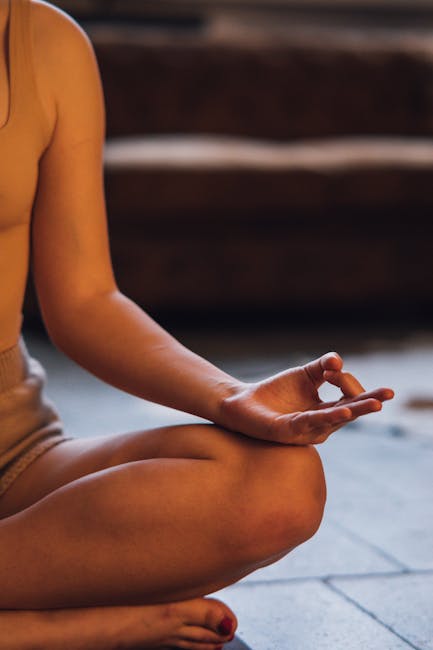Yoga Nidra is like a magical nap that doesn’t just refresh your body but also rejuvenates your mind. It’s a practice that takes you to a place between being awake and asleep, where deep relaxation happens. If you’re curious about how this works and why it’s worth trying, keep reading. We’ll dive into the world of Yoga Nidra, exploring its benefits and how it can become a part of your daily routine.
Key Takeaways
- Yoga Nidra is a guided meditation practice that promotes deep relaxation.
- It differs from traditional meditation by focusing on rest rather than concentration.
- The practice involves ten steps, including setting an intention and body scanning.
- Benefits include stress reduction, improved sleep, and enhanced emotional well-being.
- Creating the right environment and consistency in practice are crucial for maximizing benefits.
Introduction to Yoga Nidra
Definition and Overview
Guided Meditation Practice
Yoga Nidra is a form of guided meditation that leads you into a state of deep relaxation. Imagine lying down, closing your eyes, and being gently guided through a series of steps that help you unwind completely. It’s like having a personal relaxation coach in your ear.
State of Consciousness Between Wakefulness and Sleep
This practice takes you to a unique state of consciousness, somewhere between being awake and asleep. It’s a bit like that dreamy feeling you get just before you drift off to sleep, but with more awareness. This state is where the magic of deep relaxation happens.
Differentiation from Traditional Meditation
Focus on Deep Rest
Unlike traditional meditation, which often requires intense concentration, Yoga Nidra focuses on deep rest. It’s about letting go rather than holding on. You don’t need to sit cross-legged or chant; you just need to lie down and listen.
Contrast with Concentration-Based Meditation
In concentration-based meditation, you might focus on your breath or a mantra. But in Yoga Nidra, the focus is on relaxation and letting your mind wander freely. It’s like giving your brain a mini-vacation.

The Process of Yoga Nidra
The Ten Steps of Practice
Setting an Intention
The journey begins with setting an intention. This is like planting a seed in your mind, something you want to achieve or focus on during the practice. It could be as simple as “I want to relax” or “I want to feel peaceful.”
Body Scan
Next comes the body scan, where you mentally check in with each part of your body. It’s like giving yourself a mental massage, releasing tension and stress.
Breath Awareness
Breath awareness follows, where you focus on your breathing. This helps you connect with the present moment and calm your mind.
Visualization
Finally, there’s visualization, where you imagine peaceful scenes or positive outcomes. It’s like daydreaming with a purpose.
Importance of Guided Practice
Role of Recordings
Guided recordings play a crucial role in Yoga Nidra. They help you stay on track and ensure you don’t drift off into a regular nap. It’s like having a gentle guide leading you through a relaxation journey.
Maintaining Focus
Maintaining focus during Yoga Nidra is essential. The guided practice helps you stay present and aware, preventing your mind from wandering too far.

Benefits of Yoga Nidra for Deep Relaxation
Stress and Anxiety Reduction
Mechanisms of Stress Relief
Yoga Nidra works wonders for stress relief. It helps lower cortisol levels, the hormone responsible for stress. It’s like hitting the reset button on your stress levels.
Impact on Anxiety Levels
For those struggling with anxiety, Yoga Nidra can be a game-changer. It calms the nervous system and promotes a sense of peace and tranquility.
Improved Sleep Quality
Enhancing Restfulness
If you have trouble sleeping, Yoga Nidra might be the answer. It enhances restfulness, making it easier to fall asleep and stay asleep.
Addressing Insomnia
For those battling insomnia, Yoga Nidra offers a natural remedy. It helps quiet the mind and relax the body, paving the way for a good night’s sleep.
Enhanced Emotional Well-being
Emotional Balance
Yoga Nidra promotes emotional balance by helping you process and release pent-up emotions. It’s like giving your emotions a gentle hug.
Coping with Emotional Challenges
When life throws emotional challenges your way, Yoga Nidra can be a valuable tool. It provides a safe space to explore and heal from emotional wounds.

Creating the Ideal Environment for Yoga Nidra
Importance of a Quiet Space
Minimizing Distractions
Creating a quiet space is crucial for Yoga Nidra. It’s like building a cocoon where you can relax without interruptions.
Promoting Focus
A distraction-free environment helps you focus on the practice, allowing you to fully immerse yourself in the experience.
Comfort and Relaxation
Use of Props and Supports
Comfort is key in Yoga Nidra. Use props like pillows and blankets to support your body and enhance relaxation.
Temperature and Lighting Considerations
Consider the temperature and lighting in your space. A comfortable temperature and dim lighting can enhance the experience.

Tips for Maximizing the Benefits of Yoga Nidra
Consistency in Practice
Establishing a Routine
Consistency is essential for reaping the benefits of Yoga Nidra. Establish a routine and stick to it, just like brushing your teeth.
Frequency of Sessions
Aim for regular sessions, whether daily or a few times a week. The more you practice, the more benefits you’ll experience.
Staying Present and Aware
Techniques for Maintaining Awareness
Staying present during Yoga Nidra can be challenging. Use techniques like focusing on your breath or repeating a mantra to stay grounded.
Avoiding Common Distractions
Avoid common distractions like checking your phone or letting your mind wander. Stay focused on the practice to maximize its benefits.
Conclusion
Summary of Yoga Nidra’s Impact on Relaxation
Yoga Nidra is a powerful tool for deep relaxation. It reduces stress, improves sleep, and enhances emotional well-being. It’s like a mini-vacation for your mind and body.
Encouragement to Incorporate into Daily Routine
Incorporating Yoga Nidra into your daily routine can transform your life. It’s a simple practice with profound benefits. So why not give it a try and experience the magic for yourself?
For more insights on how Yoga Nidra can help with stress relief, check out this article.
If you’re interested in exploring other relaxation techniques, you might find this guide helpful.
And if you’re curious about how Yoga Nidra compares to other forms of meditation, take a look at this resource.
For more on how Yoga Nidra can be a part of your relaxation journey, visit this page.
If you’re interested in exploring other forms of meditation, check out Yoga as Meditation.
For more on the benefits of deep relaxation techniques, visit this page.
And if you’re curious about how Yoga Nidra compares to other forms of meditation, take a look at this resource.
For more on how Yoga Nidra can be a part of your relaxation journey, visit this page.
Discover the Tranquility: FAQ on How Yoga Nidra Contributes to Deep Relaxation
What is Yoga Nidra and how does it differ from regular yoga?
Yoga Nidra, often referred to as yogic sleep, is a state of conscious relaxation that is distinct from traditional yoga practices. While regular yoga involves physical postures and movements, Yoga Nidra focuses on guided meditation and deep relaxation techniques, allowing the practitioner to reach a profound state of rest and awareness without physical exertion.
How does Yoga Nidra promote deep relaxation?
Yoga Nidra promotes deep relaxation by systematically guiding the practitioner through different stages of consciousness. It helps to calm the nervous system, reduce stress, and release tension by encouraging a state of deep restfulness. This process allows the body and mind to rejuvenate, similar to the effects of a good night’s sleep.
Can anyone practice Yoga Nidra, or is it only for experienced yogis?
Yoga Nidra is accessible to everyone, regardless of their experience level. It is a gentle practice that does not require any physical postures, making it suitable for beginners and those with physical limitations. The guided nature of Yoga Nidra allows individuals of all backgrounds to experience its benefits.
How long should a typical Yoga Nidra session last?
A typical Yoga Nidra session can last anywhere from 20 to 45 minutes, depending on the practitioner’s preference and schedule. Even a short session can provide significant relaxation benefits, but longer sessions may offer deeper restorative effects.
What are the mental health benefits of practicing Yoga Nidra?
Yoga Nidra has been shown to reduce symptoms of anxiety, depression, and stress. By promoting a state of deep relaxation, it helps to calm the mind, improve mood, and enhance overall mental well-being. Regular practice can lead to increased mindfulness and emotional resilience.
How often should one practice Yoga Nidra to see benefits?
Practicing Yoga Nidra regularly, even just a few times a week, can lead to noticeable benefits. Consistency is key, and integrating it into your routine can enhance relaxation and overall well-being. However, even occasional practice can provide immediate stress relief and relaxation.
Does Yoga Nidra help with sleep issues?
Yes, Yoga Nidra is particularly effective for improving sleep quality and addressing insomnia. By promoting a state of deep relaxation and reducing stress, it can help regulate sleep patterns and enhance the overall quality of rest.
What equipment or setting is needed to practice Yoga Nidra?
Yoga Nidra requires minimal equipment. A comfortable, quiet space where you can lie down undisturbed is ideal. A yoga mat, blanket, or cushion can enhance comfort. Some practitioners also use an eye mask or headphones for guided sessions to block out distractions.
Can Yoga Nidra be practiced at any time of the day?
Yoga Nidra can be practiced at any time of the day, though it is often most beneficial when done in the morning to set a peaceful tone for the day, or in the evening to unwind and prepare for restful sleep. The key is to choose a time when you can relax without interruptions.
Is there scientific evidence supporting the benefits of Yoga Nidra?
Yes, scientific studies have shown that Yoga Nidra can significantly reduce stress and anxiety, improve sleep quality, and enhance overall well-being. Research indicates that it positively affects the autonomic nervous system, helping to lower blood pressure and heart rate, and promoting a state of deep relaxation.



